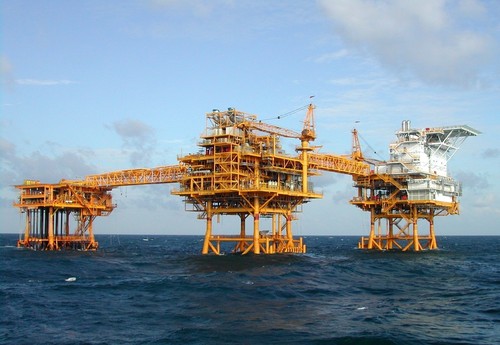(VOVworld) – Chinese Ambassador to the US Cui Tiancai justified China’s placement of oil rig Haiyang 981 in Vietnam’s exclusive economic zone (EEZ) and continental shelf, by saying that China has only one drilling rig while Vietnam has more than 30 in this area. He said Vietnam’s oil rigs are located in disputed sea areas. Vietnam rejected the statement, pointing out that oil rig Haiyang 981 is within Vietnam’s EEZ and continental shelf where Vietnam’s petroleum exploration and exploitation are in accordance with international law.
 |
Vietnam's Thang Long oil rig in the East Sea
|
Vietnam has been conducting oil and gas exploration and exploitation there in collaboration with many foreign partners.
History of petroleum exploitation
Vietnam began oil and gas exploration in its EEZ and continental shelf before national reunification in 1975. From 1969 to 1970, the administration of Vietnam’s southern region conducted research along 12,000 km of the continental shelf, which is now the area of the Cuu Long, Nam Con Son, Ma Lai, Tho Chu, and Tu Chinh-Vung May basins. In 1973 and 1974, Vietnam’s southern administration cooperated with US companies to survey Vietnam’s central offshore areas including Hoang Sa archipelago, which now covers oil and gas blocks 141, 142, 143, and 144.
After the liberation of the southern region and national reunification in 1975, Vietnam widened petroleum activities in the EEZ and continental shelf including Hoang Sa, Truong Sa, and Tu Chinh – Vung May.
Abiding by the 1982 UN Convention on the Law of the Sea
Following the National Assembly’s ratification of the 1982 UN Convention on the Law of the Sea (UNCLOS 1982) in 1996 and following the government’s instructions, the Vietnam Oil and Gas Group (PetroVietnam) has consistently complied with UNCLOS. PetroVietnam General Director Do Van Hau said: “Activities by PetroVietnam and its partners are conducted within Vietnam’s EEZ and continental shelf of 200 nautical miles. PetroVietnam has cooperated with many foreign companies in 99 exploration projects and 60 exploitation projects. PetroVietnam has carried out 2D seismic surveys on 500,000 km and 3D seismic survey on 50,000 km2 and has drilled 99 wells.”
Continuing petroleum exploration, exploitation and cooperation
Hau says PetroVietnam has maintained normal activities around oil rig Haiyang 981 over the last month. “Petroleum activities in the northeastern and northwestern sides of Hoang Sa have been taking place normally. In Vietnam’s central sea area, the China National Offshore Oil Corporation (CNOOC) has illegally conducted bidding for 9 blocks. But Vietnam has continued to work in this area. Neither foreign nor Chinese petroleum companies have signed contracts with CNOOC in this area. PetroVietnam has maintained cooperation with foreign companies including companies from the US, Russia, and Canada.”
Vietnam’s petroleum activities and its cooperation with foreign partners have continued as usual without any obstacles.
China has argued that it has only one oil rig and Vietnam has more than 30 and that Vietnam’s oil and gas blocks are in disputed areas. China can provide no facts to prove its argument. Vietnam has no oil blocks beyond its 200-nautical-mile EEZ and continental shelf. PetroVietnam’s contracts with foreign partners are recognized internationally.
Yesterday, India’s Mint news agency reported that said Videsh Limited (OVL), the global arm of the Indian Oil and Natural Gas Corporation (ONGC), will continue petroleum cooperation with Vietnam in the East Sea and even expand its operation there. OVL has invested 45% in block 061 and 100% in block 128 in Vietnam. The US’s Exxon Mobil is cooperating with PetroVietnam to survey block 117 and 118 east of Hoang Sa archipelago and will exploit oil and gas in the near future. Russian Foreign Minister Sergei Lavrov said during his visit to Vietnam in April that the key cooperation between Vietnam and Russia is petroleum. “Corporations of the two countries have discussed expansion in petroleum cooperation in line with the agreement between their leaders. Diversification in petroleum cooperation will boost trade between Vietnam and Russia.”
Confident in national waters
Conducting legal activities in Vietnam’s sovereign sea territory, abiding by international law, PetroVietnam will continue to exploit the ocean for national economic development.